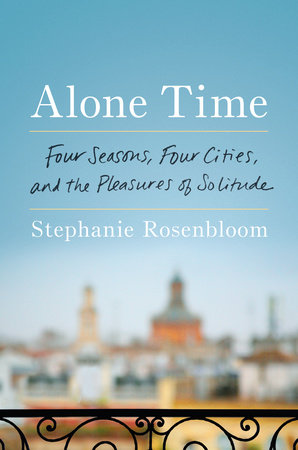Alone Time: Four Seasons, Four Cities, and the Pleasures of Solitude
- By Stephanie Rosenbloom
- Viking
- 288 pp.
- Reviewed by Susan Storer Clark
- June 6, 2018
A veteran travel writer celebrates the joy of going solo.

For some of us, exploring a city all by yourself sounds like heaven. For others, it sounds like hell. If you’re among the former, Stephanie Rosenbloom’s book is a treat. And if the whole idea scares you, Alone Time still might encourage you to try a little solitary exploration, even if you stick close to home.
Rosenbloom is the staff columnist for the travel section of the New York Times, and she got the idea for the book after going to Paris on assignment: “I had five days and a headline: ‘Solo in Paris.’ The story was up to me.”
So she walked the city, sometimes 20 miles a day, seeing “the marvelous in everyday life: a golden retriever gazing at a café chalkboard in Montmartre, as if reading the daily specials; houseboats docked along the Seine; boxes of pâtes de fruit arranged in grids like Gerhard Richter’s color charts. The city had my full attention.”
The assignment ended, and she went back home to New York. Months passed, but, she writes, “[M]y head was still in Paris.” It wasn’t the infatuation many people feel after seeing the City of Lights for the first time; she’d been there before. She missed who she was in Paris, “curious, improvisational, open to serendipity.”
Part of that had been because she was on assignment: “I would play detective; partake of everything, get up early, record the details, do the things that felt strange and uncomfortable.” To feel that way again, she decided to use her four weeks of annual vacation to explore Paris again, along with Florence, Istanbul, and, at the end, New York.
Her explorations of those cities include a few famous places, but mostly the obscure or quotidian, and every stop shows the wide range of her thought. A breakfast at Comptoir Turenne, a downscale sidewalk brasserie “on the less fashionable end of rue de Turenne,” launches a meditation on the oft-dreaded act of eating alone, quoting a variety of sources, from Nathaniel Hawthorne to the film “The Lonely Guy,” where an entire restaurant goes silent when Steve Martin’s character announces he’s there by himself.
Rosenbloom then cites a study that found people’s perceptions of single diners varied little from their feelings toward those with company. She pauses briefly to point out that the right of a woman to eat alone in public had to be fought for — and was only won fairly recently — and then moves on to the pleasure of the act.
Istanbul was next, but we don’t see her just going. She quotes Elizabeth Dunn, a researcher into wellbeing, who points out, “Anticipation is a free form of happiness.” Rosenbloom writes, “In advance of all my trips I would dig into the culture by reading novels and poetry, watching films and television programs, browsing fashion, travel, and design blogs.”
A trip to the Sakirin Mosque shows us not only the beauty of the structure, but the everyday scenes she enjoyed on the way there: “The woman in the window raising a bucket on a string, the men with pushcarts of fruits and vegetables, cats dozing between the flowerpots.”
(Rosenbloom points out that her trip took place before a series of terrorist attacks and subsequent turmoil. The U.S. State Department currently advises Americans to “reconsider travel to Turkey due to terrorism and arbitrary detentions.” Alone Time includes resources for staying safe.)
In Florence, she found difficulty avoiding hordes of tourists, even in the autumn, but she managed, discovering where city signs had been turned into impromptu art and musing about the Stendhal Syndrome, in which sufferers experience faintness or even hallucinations because of an overload of artwork. Once back in New York, she finds the way she experienced other cities has changed how she sees her own.
Alone Time concludes with “A Few Tips and Tools for Going It Alone,” a tour of websites, apps, guidebooks, services, and practical advice. The book has footnotes, and perusal of the notes section may lead to years of interesting reading.
In her introduction, Rosenbloom quotes Mihaly Csikszentmihalyi in his famous book, Flow: “Only witches and shamans feel comfortable spending time by themselves.” Still, going solo can be deeply rewarding, and Alone Time shows a masterful way to do it.
Susan Storer Clark is an occasional contributor to the Washington Independent Review of Books and author of The Monk Woman’s Daughter. She is a former radio and television journalist. She and her husband, Rich, live in the Seattle area, where they have remodeled an old farmhouse. Clark writes about history and historical fiction at www.historymuse.us. She is at work on a second novel.

